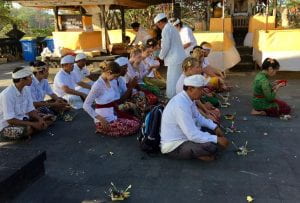So, I’ve been here in Kerambitan, Bali for about a week now, and things are hectic. Understandably, the gurus (teachers) here have much to teach us before sending us off to our host families and into Indonesian society by ourselves. For now, our days are spent around the Puri Saren Kangin—the palace at which we are currently staying—and soaking in as much cultural knowledge and Bahasa Indonesia (literally meaning “Indonesian language”) as we possibly can.
While there are many, many aspects of this first week in Indonesia that strike me deeply (too many to cover in a single post), one that I’ve found particularly surprising but quite pleasant is that Bahasa Indonesia seems to me a very easy language to learn. Over the past week, our knowledge of Bahasa has been tested through drop-off exercises in the Kerambitan area. We are required to speak with the locals and to perform certain tasks. Despite the oft hilarity of the language barrier—during which good-humored laughter serves to establish good relationships between myself and the locals—I and other program students have remarked at how less difficult it was to interact with other in Bahasa Indonesia than we assumed. From what I’ve observed so far, the reason behind this is because Bahasa has no gendered language, no conjugates, and few grammatical rules. As of now, the real challenge is to memorize the vocabulary in class.
In addition, I’ve found that it is impossible to learn any language without learning cultural norms in tandem. For instance, in Bali it is not appropriate to say “please” in Bahasa when ordering food because there is no word for “please” in that specific context. Instead direct language—such as “I will have coffee” instead of “May I have coffee, please?”—is expected. While I personally found it difficult this past week to cut off my “pleases” and “thank yous” in such contexts, I realize that it would be disrespectful of me to force my Western way of communication upon Balinese people. In that case, my adherence to Indonesian language standards aids me to participate in Indonesian society in a way that is less abrasive. In summary, I find that language goes hand in hand with culture, with a people’s way of life. Thus, my task for the duration of this semester abroad is to explore both with equal energy.
A way in which the SIT Indonesia program supports the learning of both culture and language is through excursions and drop-off sessions. During excursions, program staff accompany us on a trip to some general area of cultural site and guide us to behave appropriately in such cultural situations. During drop-off sessions, the program staff send us off to perform various tasks—including a scavenger hunt, an exercise in bargaining, and locating unfamiliar items in a market. All exercises serve to help us practice what we learn, and I deeply appreciate that aspect of the SIT Program in Indonesia, because the academic knowledge preps us for practical action. I find it heartening to know that what I learn can be enacted.
Yet, the excursions themselves hold lessons that stereotypical academic environments are unable to provide. Specifically, I realized something during one of the excursions that left me with a shaky understanding of my current place in Indonesia. We visited a temple, the Pura Tanah Lot, which was located within a wide expanse of land that catered to tourists. Despite the fact that it had only been a week, I had grown used to seeing Balinese and Balinese only. White tourists were something of a rarity. Yet, the area surrounding the Pura Tanah Lot was filled with tourists, and not all of them light-skinned. But, to be fair, the majority percentage of the tourist population there was white. And as I saw them walking past, I felt a startling sensation of recognition, that realization that America and white people still existed. Yet, I didn’t identify with any of the tourists. And I don’t identify with the Balinese. I feel like neither.
In fact, I am neither, despite my greater relation to the American tourists. And I realized this after some tourists committed a shocking blunder. To be short, they entered into a building off-limits to tourists because only those in full pakaian adat (traditional clothing) can enter. We students had previously acquired some pakainan adat, and thus, were currently situated within the temple. It is easy to excuse their behavior as ignorant, but knowing the importance of these rules makes it difficult to forget. What little cultural knowledge about Bali that I currently possess is a great and necessary privilege. If I weren’t participating in the SIT program, then I could have easily been in those tourists’ shoes, and that is a terrifying thought. It goes to show that even as a tourist, a brief visitor, it is irresponsible to not understand, because it is all too easy to commit a disrespect.
Thank you, and until next time!





In our westernized language – “Thanks” for the blog post. “Please” keep them coming.
In Bahasa cultural language – I want posts to continue with such clarity, depth, and insight.
Ditto Rick, keep them coming! See, I like this “command” of the language, no please or thank you for you.
I appreciate the insights and how you are sharing your experiences. I thoroughly enjoy reading what you write.
As always, I love what you have to say. Thank you for sharing. I’m excited to read more! ♥️